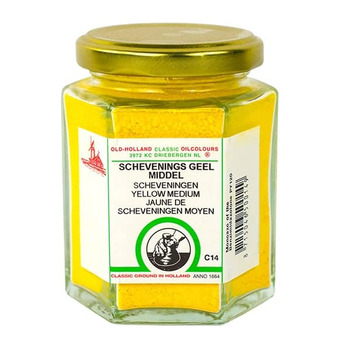Your Cart
SLI Search Template
Related Categories: 2" Brush | Synthetic Fan Brush | Wilson Bickford Products | Pallette Knife | Oil Sets | Palette Tools | Knife | Paint Pallet
There were no results that contained all of the words in your query. These results contain some of the words.
-

 Old Holland Classic Pigment Schev. Yellow Medium 30gSave Up to40%Off listYellow Prepare custom paints and base liquids with these pure, light-fast pigments and high quality raw materials! For the artists who prefer to create their own paints, Old Holland Classic Pigments and Raw Materials offers a carefully selected range of 98 light-fast dry pigments. Old Hollands organic, anorganic and synthetic organic pigments have outstanding color strength, clarity and intensity. Six different raw materials, from dammar resin to hide glue, allow artists and restorers to create their own base liquids. Old Holland uses these pigments to make all its paints. The pigments have an outstanding colour strength, clarity and brilliance Key Features: * Wide range of light-fast pure pigments * 98 light-fast dry pigments * Excellent color strength, clarity and brilliance * Organic pigments include Carmine, Indian Yellow and Madder Lacquer * Anorganic pigments include Umbers, Cadmiums and mineral pigments Perfect For: * Artists who prefer to create their own paints * Artists working in oils * Restoration work * Painting on canvas pigments can be divided into three groups: Group 1: Organic pigments Of natural origin, animal or vegetable (living), usually carbon compounds. Some examples: Carmine (from the Cochineal insect), Gummigutta, Gamboge (from the gum resin of the Garcinia Tree), Indian Yellow (from the urine of cows that eat mango leaves), Mummy (from the remains of Egyptian mummies), Madder Lacquer (from the root of the common Madder plant). Group 2: Anorganic pigments: Chemical compounds from chemical elements other than carbons (non-living). Some examples divided into three subgroups:Earth pigments: Ochres, Umbers, Green Earth, Caput Mortuum, Venetian Red. Mineral pigments: Malachite, Vermillion, Lapis Lazuli. Synthetic inorganic pigments (do not occur in nature but are manufactured): Prussian Blue, Ceruleum Blue, Lead White, Cadmiums. Group 3: Synthetic organic pigmentsComplex carbon compounds which do not occur in nature, but are created in the laboratory. Some examples: Phtalocyanine Blues and Greens, Quinacridones, Isoindolinones, Dioxazine, Azo Pigments. See More
Old Holland Classic Pigment Schev. Yellow Medium 30gSave Up to40%Off listYellow Prepare custom paints and base liquids with these pure, light-fast pigments and high quality raw materials! For the artists who prefer to create their own paints, Old Holland Classic Pigments and Raw Materials offers a carefully selected range of 98 light-fast dry pigments. Old Hollands organic, anorganic and synthetic organic pigments have outstanding color strength, clarity and intensity. Six different raw materials, from dammar resin to hide glue, allow artists and restorers to create their own base liquids. Old Holland uses these pigments to make all its paints. The pigments have an outstanding colour strength, clarity and brilliance Key Features: * Wide range of light-fast pure pigments * 98 light-fast dry pigments * Excellent color strength, clarity and brilliance * Organic pigments include Carmine, Indian Yellow and Madder Lacquer * Anorganic pigments include Umbers, Cadmiums and mineral pigments Perfect For: * Artists who prefer to create their own paints * Artists working in oils * Restoration work * Painting on canvas pigments can be divided into three groups: Group 1: Organic pigments Of natural origin, animal or vegetable (living), usually carbon compounds. Some examples: Carmine (from the Cochineal insect), Gummigutta, Gamboge (from the gum resin of the Garcinia Tree), Indian Yellow (from the urine of cows that eat mango leaves), Mummy (from the remains of Egyptian mummies), Madder Lacquer (from the root of the common Madder plant). Group 2: Anorganic pigments: Chemical compounds from chemical elements other than carbons (non-living). Some examples divided into three subgroups:Earth pigments: Ochres, Umbers, Green Earth, Caput Mortuum, Venetian Red. Mineral pigments: Malachite, Vermillion, Lapis Lazuli. Synthetic inorganic pigments (do not occur in nature but are manufactured): Prussian Blue, Ceruleum Blue, Lead White, Cadmiums. Group 3: Synthetic organic pigmentsComplex carbon compounds which do not occur in nature, but are created in the laboratory. Some examples: Phtalocyanine Blues and Greens, Quinacridones, Isoindolinones, Dioxazine, Azo Pigments. See More
Powered by












Login and Registration Form
Customer Login
Already a customer ? Sign in now for the best experience!
* indicates a required field